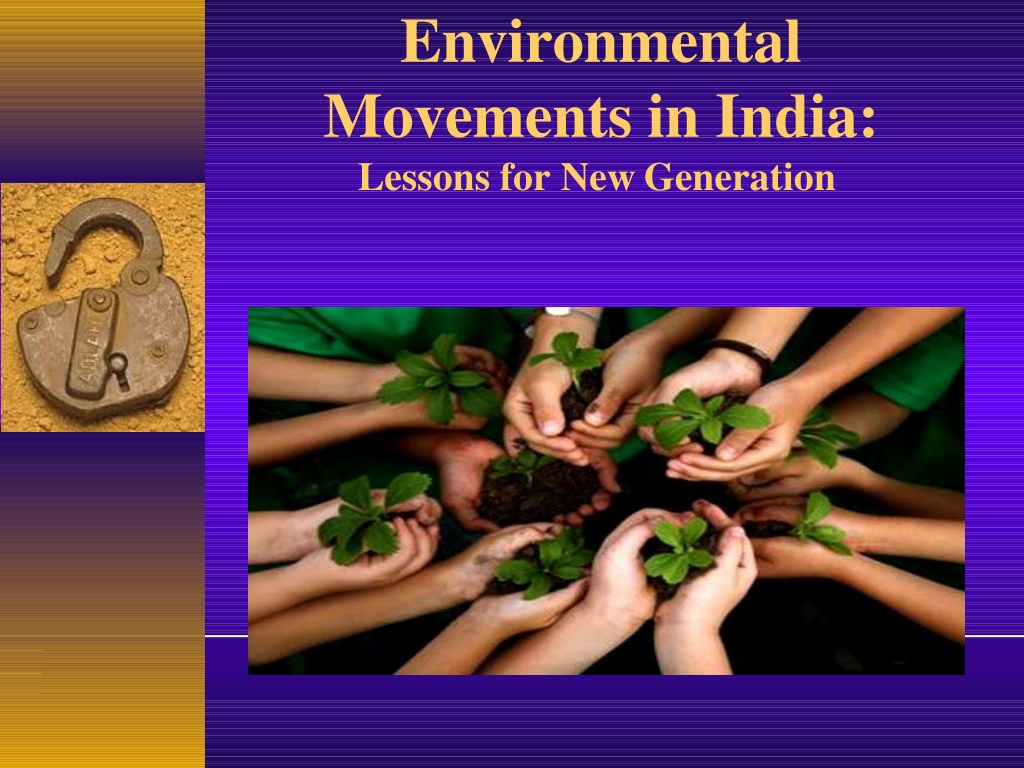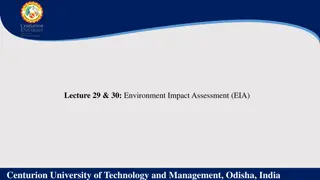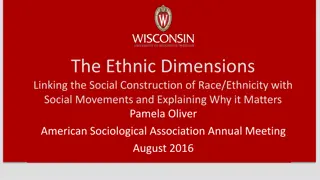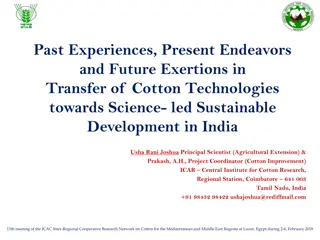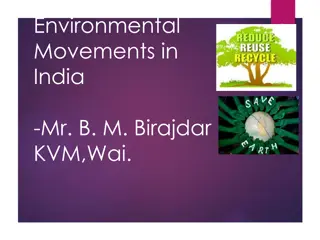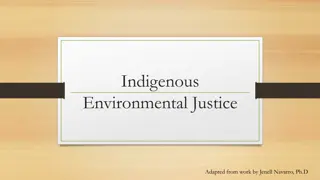Environmental Movements in India: Lessons for a Sustainable Future
Environmental movements in India have evolved over time, driven by concerns of unbridled resource exploitation and environmental degradation. The emergence of these movements has been marked by a common interest in protecting the environment through policy changes and collective action. With a focus on historical evolution, ideological trends, and major movements, the narrative underscores the urgency of adopting new environmental approaches. Various stakeholders, including government bodies, private sector, NGOs, individuals, youth, and women, play crucial roles in shaping a sustainable future. The content delves into the challenges posed by consumerist lifestyles and resource misuse, emphasizing the need for collective efforts to address environmental issues.
Download Presentation

Please find below an Image/Link to download the presentation.
The content on the website is provided AS IS for your information and personal use only. It may not be sold, licensed, or shared on other websites without obtaining consent from the author. Download presentation by click this link. If you encounter any issues during the download, it is possible that the publisher has removed the file from their server.
E N D
Presentation Transcript
Environmental Movements in India: Lessons for New Generation
CONTENTS Introduction Historical Evolution of Environmental Movement Ideological Trends in Indian Environmentalism Emergence of Environmental Movements in India Major Environmental Movements in India Environmental Movement and Issues on Environmentalism Towards New Environmentalism: Lessons for New Generation Role: Government - Private -NGO S-Individual Role of Youth - Role of Women Summary + APPEAL SINCE1881
Understanding on Environmental Movement SINCE1881
Introduction Environment plays a vital role in human living - The environment comprises of all the natural resources such as air water, land, forests, and minerals - It is responsibility of populace to protect the natural resources Environmental Movement : Form of social movement that involves an array of individuals, groups and coalitions that perceive a common interest in environmental protection and act to bring about changes in environmental policies and practices Issue: Experiences an almost unrestricted exploitation of resources because of the lure of new consumerist lifestyles - The balance of nature is disrupted - This has led to many conflicts in the society Due to technical advancement and other reasons, there is a lot of misuse of natural resources, in the form of land degradation, water pollution, air pollution, and deforestation - All these factors lead to worsening of environment SINCE1881
Introduction - Issues There has been a consistent increase in the consciousness and concern about it around the globe Resulted to widespread protest movements by aggrieved communities and concerned inhabitants Numerous hazardous and disastrous incidents that led to ecological crisis in the human history Environmental movement is global movement, signified by a range of organizations, from the large to grassroots and differs from country to country It also including conservation and green politics is a dissimilar scientific, social, and political movement to address environmental issues Includes private citizens, professionals, religious devotees, politicians, scientists and non-profit organizations Great efforts are being made in order to regain the environment by people through voluntary organizations, which have concerns about the environment SINCE1881
Historical Evolution of Environmental Movement India has the oldest and most diverse environmental movement inAsia It is more deeply rooted and integrated within its host civilization than any other environmental movement Early record in India : Epic Mahabharata, where the clash between the Aryans, pastoralists and agriculturists, and the Nishads, forest-dwellers Kautilya s Artha Shastra- Kings to protect forests and wild life, particularly elephants The cultural values in favour of protection of environment were strong enough to give rise to the institution of the sacred groves or Devara Kadu Several ancient hymns were in praise of nature and specially prayed God to bless the Earth with regular rainfall and greenery SINCE1881
Ideological Trends in Indian Environmentalism Crusading Gandhians Relies heavily on a moral/religious idiom in its rejection of the modern way of life Ecological Marxist Problem in political and economic terms, arguing that it is the unequal access to resources, rather than the question of values, which better explains the environmental degradation Appropriate Technology Emphasis is not so much on challenging the system as in demonstrating in practice a set of socio-technical alternatives to the centralizing and environmentally degrading technologies Wilderness Enthusiasts Provided massive documentation of the decline of natural forests and their plant and animal species, urging the government to take remedial action Scientific Conservation Concerned with efficiency and management patterns and processes of SINCE1881
Major Environmental Movements in India Bishnoi Movement Chipko Movement Save Silent Valley Movement Jungle Bachao Andholan Appiko Movement Narmada Bachao Andholan (NBA) Tehri Dam Conflict SINCE1881
Bishnoi Movement Year: 1700s - Place: Khejarli, Marwar region, Rajasthan state - Leaders: Amrita Devi along with Bishnoi villagers in Khejarli and surrounding villages Aim: Save sacred trees from being cut down by the king s soldiers for a new palace Amrita Devi hugged the trees and encouraged others to do the same - 363 Bishnoi villagers were killed in this movement - The Bishnoi tree martyrs were influenced by the teachings of Guru Maharaj Jambaji, who founded the Bishnoi faith- King who came to know about these events rushed to the village and apologized, ordering the soldiers to cease logging operations - Maharajah designated the Bishnoi state as a protected area, forbidding harm to trees and animals This legislation still exists today in the region SINCE1881
Chipko Movement Year: 1973 - Place: In Chamoli district and later at Tehri-Garhwal district of Uttarakhand - Leaders: Sundarlal Bahuguna, Gaura Devi, Sudesha Devi, Bachni Devi, Chandi Prasad Bhatt, Govind Singh Rawat, Dhoom Singh Negi, Shamsher Singh Bisht and Ghanasyam Raturi - Aim: To protect the trees on the Himalayan slopes from the axes of contractors of the forest Bahuguna - importance of trees in the environment which checks the erosion of soil, cause rains and provides pure air - The women of Advani village of Tehri-Garhwal tied the sacred thread around trunks of trees and they hugged the trees, hence it was called Chipko Movement or hug the tree movement - The main demand of the people was that the benefits of the forests (especially the right to fodder) should go to local people Gathered momentum in 1978 when the women faced police firings and other tortures. The then state Chief Minister, Hemwati Nandan Bahuguna set up a committee to look into the matter, which eventually ruled in favor of the villagers- Became a turning point in the history of eco-development struggles in the region and around the world SINCE1881
Save Silent Valley Movement Year: 1978-Place: Silent Valley, an evergreen tropical forest in the Palakkad district of Kerala, India - Leaders: The Kerala Sastra Sahitya Parishad (KSSP) an NGO, and the poet-activist Sughathakumari played an important role in the Silent Valley protests- Aim: In order to protect the Silent Valley, the moist evergreen forest from being destroyed by a hydroelectric project The Kerala State Electricity Board proposed a hydroelectric dam across the Kunthipuzha River that runs through Silent Valley- 1973, the Planning Commission approved the project at a cost of about Rs 25 crores- Many feared that the project would submerge 8.3 sq km of untouched moist evergreen forest- Several NGOs strongly opposed the project and urged the government to abandon it. 1981, bowing to unrelenting public pressure, Indira Gandhi declared that Silent Valley will be protected-In June 1983 the Center re-examined the issue through a commission chaired by Prof. M.G.K. Menon- In 1985, Prime Minister Rajiv Gandhi formally inaugurated the Silent Valley National Park SINCE1881
Jungle Bachao Andholan Year: 1982 Place: Singhbhum district of Bihar Leaders: The tribals of Singhbhum Aim: Against governments decision to replace the natural salt forest with Teak The tribals of Singhbhum district of Biharstarted the protest when the government decided to replace the natural salt forests with the highly- priced teak This move was called by many as Greed Game Political Populism Later this movement spread to Jharkhand and Orissa SINCE1881
Appiko Movement Year: 1983 - Place: Uttara Kannada and Shimoga districts of Karnataka State - Leaders: Pandurang Hegde - He helped launch the movement in 1983-Aim: Against the felling and commercialization of natural forest and the ruin of ancient livelihood Southern version of the Chipko movement - The Appiko Movement was locally known as Appiko Chaluvali - The locals embraced the trees which were to be cut by contractors of the forest department - The Appiko movement used various techniques to raise awareness such as foot marches in the interior forest, slide shows, folk dances, street plays etc The movement later focused on the rational use of ecosphere through introducing alternative energy resource to reduce pressure on the forest. The movement became a success. The current status of the project is stopped SINCE1881
Narmada Bachao Andholan (NBA) Year: 1985 - Place: Narmada River, which flows through the states of Gujarat, Madhya Pradesh and Maharashtra - Leaders: Medha Patker, Baba Amte, adivasis, farmers, environmentalists and human rights activists - Aim: A social movement against a number of large dams being built across the Narmada River Protest for not providing proper rehabilitation and resettlement for the people -construction of Sardar Sarovar Dam-Later on, the movement turned its focus on the preservation of the environment and the eco-systems of the valley - World Bank withdrew from the project- In October 2000, the Supreme Court gave a judgment approving the construction of the Sardar Sarovar Dam with a condition that height of the dam could be raised to 90 m-This height is much higher than the 88 m which anti-dam activists demanded-The project is expected to be fully com-pleted by 2025-Although not successful, as the dam could not be prevented, the NBA has created an anti-big dam opinion in India and outside SINCE1881
Tehri Dam Conflict Year: 1990 s - Place: Bhagirathi River near Tehri in Uttarakhand-Leaders: Sundarlal Bahuguna Aim: The protest was against the displacement of town inhabitants and environmental consequence of the weak ecosystem Tehri dam attracted national attention in the 1980s and the 1990s The major objections include, seismic sensitivity of the region, submergence of forest areas along with Tehri town etc Despite the support from other prominent leaders like Sunderlal Bahuguna, the movement has failed to gather enough popular support at national as well as international levels SINCE1881
Issues on Environmentalism Plays a vital role in our survival-Includes all the natural resources such as air water, land, forests, minerals, etc To protect the natural resources There is a lot of misuse of these natural resources, in the form of land degradation, water pollution, air pollution, deforestation - Lead to deterioration of our environment Many efforts made in order to reclaim the environment- People have revoked and adopted non-violent action movements-Based on short-term criteria of exploitation Micro-action plans to safeguard natural resources and to provide the macro concept for ecological development at the national and regional levels Witnessed a high rate of resource- Conflicts, which are based on the deteriorating condition of the natural resources -Leading to environmental movements at different levels SINCE1881
Towards New Environmentalism Lessons for New Generation Influencing government decisions, special interests have some built-in advantages over the general public interest Special interests can organize more effectively, and generate benefits for elected officials Government enacted numerous significant environmental laws- Backbone of federal policies toward environmental problems Truly innovative in their policies and their designs - They pitted the general public interest in improving environmental quality Need innovative approaches to address continuing and emerging environmental problems Media attention plays a key role in creating the public s awareness of any urgent problem Policy innovations are not yet as favorable as they were in this earlier period Leadership may be capable of altering those conditions, but as yet the public s concern about the adverse effects of Environmental problems SINCE1881
Towards New Environmentalism ROLE OF INTERNATIONALINSTITUTIONS GOVENMENTS PRIVATE CORPORATES NON GOVERNMENT ORGANISATIONS PUBLIC INDIVIDUAL MASS/SOCIAL MEDIAFAMILY SINCE1881
Role of Youth & Media Role of youth is central - Youth have both special concerns and special responsibilities in relation to the environment Youth in grass-roots activism, conservation projects, policy-making bodies and NGOs Youth have a special talent for invention and the development of new forms of action and activism and can generate more effective responses to environmental issues Social movements rely on the media, information sharing, protests, demonstrations, boycotts, and events geared to attract media publicity Environmental education and the media could join in a larger process of social learning Professionalized Environmental Journalism SINCE1881
Role of Women Women should be encouraged to participate in environmental protection projects, programs, and policies Women s access to land and other resources should be ensured and not undermined The government will have to come in to ensure gender equity regarding access to and control of resources Women education and access to education for girls should be seen as a policy priority - Environmental education for women will produce change in attitude of the people, as well as impact specific knowledge on the every women and family Educated women will contribute more significantly to bridging the gap between environment and development Empowerment of women in sustainable human development and in relation to the protection of the environment must be recognized and sustained SINCE1881
APPEAL YOUTH & GENDER CONCERNED ENVIRONMENTAL EDUCATION PLEASE EACH ONE TEACH ONE IF NOT EACH ONE CATCH ONE AND TEACH ONE SINCE1881
Questions Please.. SINCE1881
